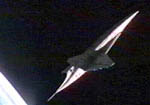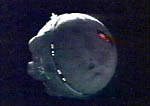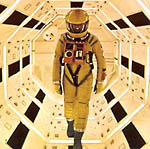

| "2001: A Space Odyssey" By Rob Caswell, with the generous help of Phil Sterett. Kubrick's vision for the year 2001 holds up reasonably well, considering its 1960's perspective. This is due, in no small part, to the dedication and passion that hardware designers Fred Ordway and Harry Lange brought to the film. These craft remain some of the most plausible created for sci-fi cinema. The craftsmanship of the models was also ground breaking. They were some of the first movie models to use small parts from plastic kits to detail and texture - a practice that's since become a standard. The study of 2001's studio models is just that: a study. Kubrick had a penchant for destroying his props after production. His goal was to make sure that things like spacecraft were not later reused in low budget sci-fi flicks, thus cheapening his original work. He even destroyed the plans used to create the vehicles and sets. While an artistically admirable goal, it left us with the barest scattering of 2001 movie artifacts. In the absence of real models, careful research is required in order to piece together the details of these landmark movie spacecraft. The most obvious and readily available source for reference is the film, itself. However there are some other images out there - out takes, promo shots, etc. Our goal with this page is to try to assemble as many of those resources as possible. We've gone back to periodicals released in the 60's, pictures from original program books, and more. We also share our information and observations on the various craft in the sections below. Probably the best printed source of 2001 reference is the book Filming the Future, by Piers Bizony. We have avoided including pictures that are redundant to that volume, unless we had a significantly superior reproduction of an image. Do you have any other unique 2001 photos or information? If so and you're willing to have them posted here, please contact Rob. Our goal is to make this the Web's most complete 2001 resource for sci-fi modelers. To do that we could use your help. |
Satellites | Orion III | Space Station 5 | Aries IB | Moonbus | Discovery | Pods | Spacesuits
Starship Modeler 2001 Modeling Page | Starship Modeler Home
|
satellites | ||

IMAGES: |
"Here are some stills from the 2001 DVD showing the four nukes as Soviet, US, French, German and Chinese in that order. If you look closely at the first satellite in the film you see a US air-force insignia (you can just make the insignia out in on the tower). . The second is German; you can clearly see the German flag here. So, that is a Maltese cross you see there. The third satellite is French as can be seen from the French air force insignia here. The last satellite is Chinese with a red star and bar. The image here just shows this under the "cannons" at the back of the nuke. Thus the nuke that was cut from the film is Soviet, probably because the US nuke matched up better to the flying bone at the end of the Dawn of Man sequence." |
|
| orion III | ||
 IMAGES: |
|
|
| space station 5 | ||
 IMAGES: |
|
|
| aries Ib | ||
 IMAGES: |
|
|
| moonbus | ||
 IMAGES: |
|
|
| discovery | ||
 IMAGES: |
|
|
| eva pods | ||
 IMAGES: |
|
|
| space suits |
||
 IMAGES: |
|
|
|
2001 is ©1968 Turner Entertainment Co. and 2010 is ©1984 Turner Entertainment Co., all rights reserved. This page is best viewed by a system carrying the 'Twentieth Century MT' font. Please direct comments, questions, corrections, and picked nits to the Starship Modeler staff. Last updated 10 June 2008. This page copyright © 1999-2008, Starship Modeler. |